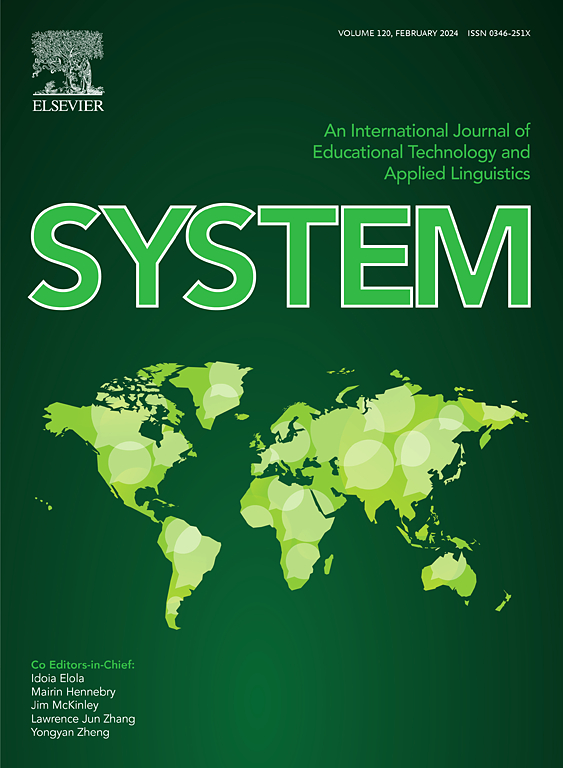外语焦虑是可塑的吗?纵向观察研究的系统综述
IF 5.6
1区 文学
Q1 EDUCATION & EDUCATIONAL RESEARCH
引用次数: 0
摘要
外语焦虑(FLA)一直是语言学习研究的焦点,人们越来越关注外语焦虑随时间的变化。认识到FLA是一个动态的结构,本文审查了FLA的变化是如何被实证检验的,重点是时间框架、方法方法和可延展性的证据。方法1986年以来以英文发表的纵向观察研究,采用至少两个测量点的人体内设计。系统检索了ERIC、British Education Index、PsycINFO、Scopus和Web of Science数据库。使用混合方法评估工具(MMAT)评估研究质量和偏倚风险。根据时间设计(宏观、中观、微观时间尺度)、数据收集工具和分析方法,对研究结果进行了叙述性综合。结果49项研究符合纳入标准。宏观层面的设计主要是在较长的时间间隔内使用自我报告问卷来捕捉广泛的发展趋势。中观和微观水平的研究采用更密集的抽样,包括重复评分、独特动力学程序和生理测量,以揭示短期波动。很少有研究使用多时间尺度设计,但研究结果反映了逐渐和瞬间的变化,表明FLA可以在不同的时间框架内变化。虽然大多数研究至少满足三项MMAT标准,但观察到的FLA变化并没有因研究质量而系统性差异。研究结果证实了FLA的动态性质。其跨时间框架的可变性强调了未来研究需要采用多时间尺度和混合方法设计,以更有效地捕获FLA开发的复杂性。本文章由计算机程序翻译,如有差异,请以英文原文为准。
Is foreign language anxiety malleable? A systematic review of longitudinal observation studies
Background
Foreign language anxiety (FLA) has long been a focus in language learning research, with increasing attention paid to how it changes over time. Recognising FLA as a dynamic construct, this review examines how FLA change has been empirically examined, focusing on temporal frameworks, methodological approaches, and evidence of malleability.
Methods
Longitudinal observation studies published in English since 1986 were included if they used a within-person design with at least two measurement points. A systematic search was conducted of the ERIC, British Education Index, PsycINFO, Scopus, and Web of Science databases. Study quality and risk of bias were assessed using the Mixed Methods Appraisal Tool (MMAT). The findings were narratively synthesised according to temporal design (macro-, meso-, micro-timescales), data collection tools, and analytic approaches.
Results
Forty-nine studies met the inclusion criteria. Macro-level designs primarily used self-report questionnaires at extended intervals to capture broad developmental trends. Meso- and micro-level studies employed denser sampling, including repeated ratings, idiodynamic procedures, and physiological measures, to reveal short-term fluctuations. Few studies used multi-timescale designs, but the findings reflected both gradual and momentary changes, indicating that FLA can vary across temporal frameworks. While most studies met at least three MMAT criteria, the observed changes in FLA did not differ systematically by study quality.
Discussion
The findings confirm the dynamic nature of FLA. Its variability across timeframes underscores the need for future research to employ multi-timescale and mixed-methods designs to more effectively capture the complexity of FLA development.
求助全文
通过发布文献求助,成功后即可免费获取论文全文。
去求助
来源期刊

System
Multiple-
CiteScore
8.80
自引率
8.30%
发文量
202
审稿时长
64 days
期刊介绍:
This international journal is devoted to the applications of educational technology and applied linguistics to problems of foreign language teaching and learning. Attention is paid to all languages and to problems associated with the study and teaching of English as a second or foreign language. The journal serves as a vehicle of expression for colleagues in developing countries. System prefers its contributors to provide articles which have a sound theoretical base with a visible practical application which can be generalized. The review section may take up works of a more theoretical nature to broaden the background.
 求助内容:
求助内容: 应助结果提醒方式:
应助结果提醒方式:


